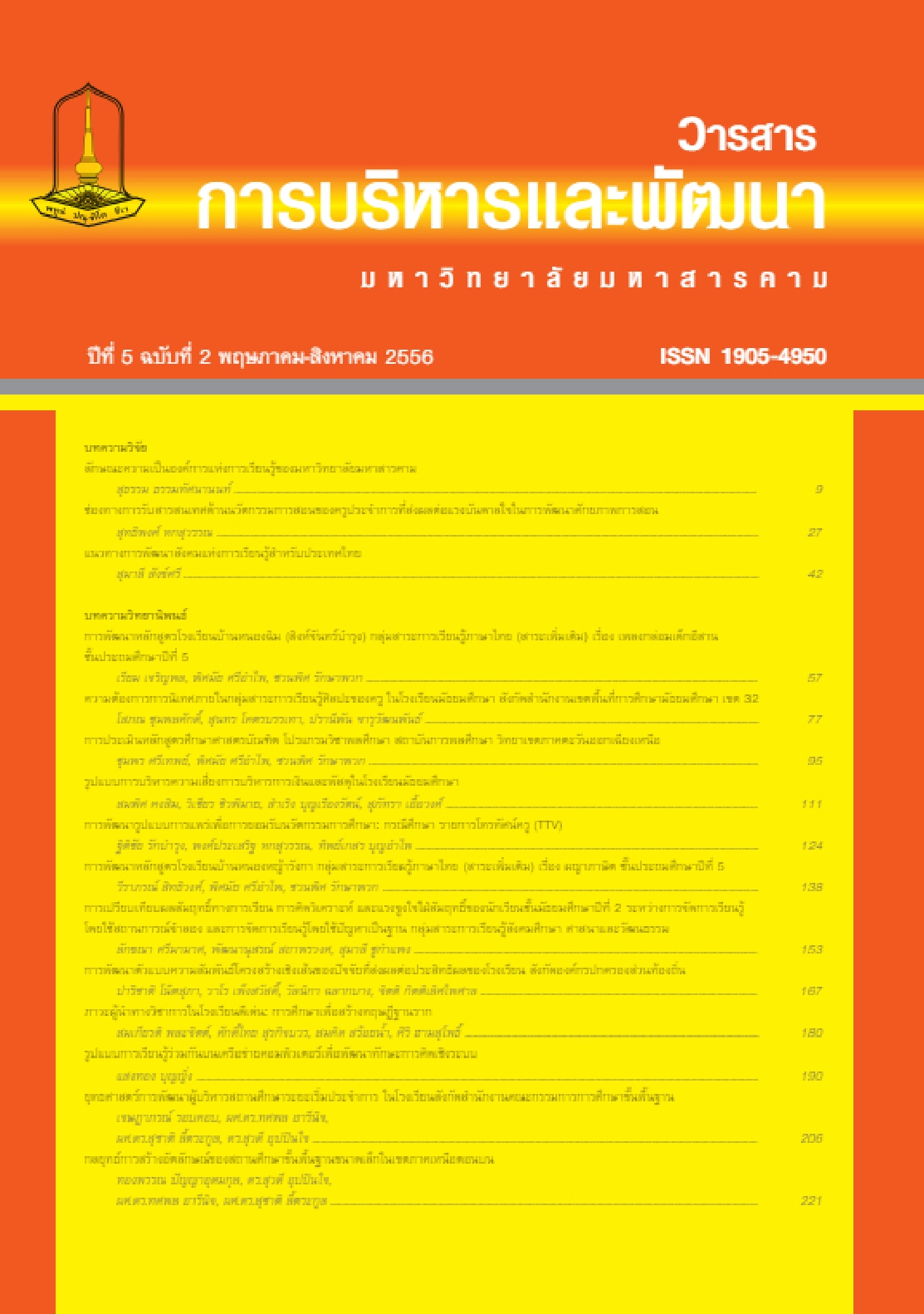Learning Organization Characteristics of Mahasarakham University.
Main Article Content
Abstract
The purposes of this dissertation were 1) to study the perceptions of faculty members andacademic supporting staff toward the learning organization characteristics of Mahasarakam University inoverall aspect and each of five aspects: systems thinking, mental models, shared vision, team learning, and personal mastery and 2) to study the relationship between environmental factors, administrative factors, human factors, and academic integration factors and learning characteristics of Mahasarakham University. The sample of the study consisted of 306 faculty members and academic supporting staff
of Mahasarakham University. The research instrument used for collecting data was a fiveratingscale questionnaire with 96 items. Arithmetic mean, standard deviation, t–test, Pearson product moment correlation and multiple correlation were utilized for data analysis.
The results of the study were as follows:1. Learning organization characteristics of Mahasarakham university in holistic and individual aspects such as systemic thinking, planned thinking, shared vision, team-worked learning, and holistic self-knowing aspects
2. H 2. Holistic were high and individual environmental, administrative, personal, academic integration factor parameters were at high level
3. The environmental factors: organization culture and climate, organization structure and work, and physical environment had statistically positive relationship at the highlevel with the learning organization characteristics of Mahasarakham
University at .05 level.
4. The administrative factors: change management and innovations, and performance standards had statistically positive relationship at the highest level with the learning organization characteristics of Mahasarakham University at .05 level. While the transformational leadership ,empowerment, and human resource development had statistically positive relationship at the high-level with the learning organization characteristics of Mahasarakham University at .05 level.
5. The human factors: motivation, job satisfaction, and organization commitment, had statistically positive relationship at the highest level with the learning organization characteristics of Mahasarakham University at .05 level.
6. The academic integration factors: learning in organization, knowledge building and transfer and knowledge management had statistically positive relationship at the highest level with the learning organization characteristics of Mahasarakham University at .05 level.
Downloads
Article Details
References
Ministry of Education (2007). News from the Ministry of Education. Retrieved on 8 February 2007, from http://www.moe.go.th
Chanpen Sitthiwongse (2002). Relationship between creation of empowerment in work and job satisfaction of staff nurses of Srinagarind Hospital. Thesis of Bachelor of Nursing Science (Nursing Administration). Khon Kaen: Graduate School Khon Kaen University.
Jitthawin Chantraboon (2008). Relations between leadership, organizational climate, conflict and dealing with conflicts of head nurses based on recognition of registered nurses of Community Hospital Area 3. Thesis of Bachelor of Nursing Science (Nursing Administration). Phitsanulok: Graduate School Naresuan University. Copied.
Chatchanok Saisuwan (2008). Adjusted influence of vocational teachers and organizational climate as perceived on the causal model of the requirements at individual level in leading to the organization of learning. Thesis of Curriculum and Teaching (Educational Research Methodology). Bangkok. Graduate School Chulalongkorn University. Copied.
Tula Mahasuthanont (2004) Principle of Management and Principle of Administration. Bangkok: Permsup Printing House.
Ministry of University Affairs (2001). Report of the Seminar on Advancement of Thai Education. Bangkok: Ministry of University Affairs.
Narumon Kongpasuk (2005). Learning Organization: a Case Study of Raman Hospital. Master of Arts (Social Development). Bangkok: Graduate School Project of National Institute of Development Administration. Copied.
Namthip Wipawin (1994). Managing Knowledge and Knowledge Warehouse. Bangkok: SR Printing Mass Products.
Nisadal Wechayanont (1998). Concept on Creating Learning Organization. Journal of Public and Private Management 7(1): 1 – 21.
Blanchard, Ken., Carlos, John., Randolph, Alan (2001). Decentralized Organization. Translated by Wannaporn Krailert. Bangkok: Siam Silp Print and Pack. FedEx Delivers.
Pornthida Wichianpunya (2004). Knowledge Management: Basic and Application. Bangkok: Expernet.
------------ . (2004 Kor). Knowledge Management. Bangkok: Expernet.
Porter, Michael E. (2005). Strategy and Internet to Create a Competitive Advantage. Translated by Thitinant Itharat. Bangkok: Expernet.
Wichan Panich (2005). Knowledge Management: Practitioner. Bangkok: Mental Health.
Werawut Makasiranont (2003). Learning Organization to Genius Organization. Bangkok: Expernet.
Werawat Punnitamai (2001). Learning Organization Development. 2nd Edition. Bangkok: Theerapom Literature.
Siriporn Pongsriroj (1997). Organization and Management. 6th Edition. Bangkok: Technique 19.
Office of the Education Council, Ministry of Education (2005). Officials Development Strategic Plan 2005-2008. Bangkok: Prik Wan Graphics.
Bureau of Standards and Evaluation, Ministry of University Affairs (2003). Student Training Course to Support for Quality Assurance within Higher Education Institutions. Bangkok: Sahamitr Printing.
Brown, W.B; & Moberg, D. J. (1980). Organization Theory and Management: A Macro Approach.New York: John Wiley & Sons.
Ceppeteli, E.B. (1995, October). Building a Learning Organization Beyond the Wall. Journal of Nursing Administration. 25: 56 – 60.
Senge, P.M. (1990). The Fifth Discipline:The Art and Practice of the Learning Organization. London:Century Press.
Tempongko, Ma. Sandra B.; et al. (2005). Capacity Building for Health Empowerment: A Case Study.Journal of Southeast Asian Education. 5(1 – 2): 103 – 118.


